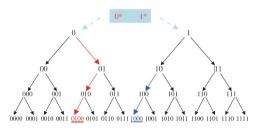September 28, 2009 feature
How Did Evolution Begin?

(PhysOrg.com) -- Life's ability to replicate itself is essential for evolution, yet even the simplest kind of replication requires a relatively complex system. So what kind of non-replicating system might have served as the predecessor of evolution, paving the way for life as we know it? The answer, according to a recent study, is a kind of "prelife" -- a chemical system that can lead to information and diversity, and that is capable of selection and mutation, but does not yet have the ability to self-replicate.
In their study, Hisashi Ohtsuki of the Japan Science and Technology Agency and the Tokyo Institute of Technology, along with Martin Nowak of Harvard University, have investigated how evolution might have first begun. As the researchers explain, the origin of life is a transition from chemistry to biology, and has been widely studied. Here, Ohtsuki and Nowak have presented a model where a purely chemical system (prelife) becomes more efficient (catalytic prelife) and then builds the sequences needed for replication, finally resulting in life. Their work is published in a recent issue of Proceedings of the Royal Society B.
“As you know, the ability of replication is critical for life,” Ohtsuki told PhysOrg.com. “We can conceive several forms of life, such as prelife catalysts and replicators, as in our paper. We are interested in which form of life is most efficient and thus is selected in prelife (a soup of chemicals). The significance of our study is that we have mathematically shown for the first time that replicators, which have the ability to remain attached with a growing sequence, have a great advantage over the other forms of life. Replication is usually taken for granted in the study of evolution. We think that our result gives a justification of why replicators are so dominant.”
In the scientists’ model, prelife is made of two types of monomers (0 and 1) that randomly link together to form a polymer chain. By adding a 0 or a 1, longer chains are produced from shorter ones. The researchers created a simple tree of life based on this growth process, where either a 0 or a 1 is added to the end of the preceding chain to make a longer one. Though starting with just a single monomer, this tree of prelife has infinitely many lineages.
As the researchers explain, some of these prelife sequences are catalysts, and can enhance certain reactions in prelife. Specifically, they increase the rate at which monomers are added to sequences in the specific prelife reactions that created them. The faster the rate of reactions to create a certain prelife catalyst, the more of them there will be. As the researchers found, the sequences that are most highly selected among prelife catalysts are perfectly catalyzed prelife sequences (those that enhance the rates of all their upstream reactions).
“Prelife refers to chemical reactions in a soup of chemicals that consists of amino acids, phosphoric acids, nucleobases, and so on,” Ohtsuki explained. “Simply speaking, prelife supplies ‘materials’ for life. But prelife does not have an ability of replication, because it cannot catalyze any reactions. Catalytic prelife is a big step forward for life, because it can enhance certain reactions. A most promising candidate for life among prelife catalysts are those which can catalyze their own upstream reactions. We believe that catalytic ability is a big step, yet not enough for the emergence of life, as we have shown in our paper: we need another step, that is, replicators.”
Replicators - for example, a simple sequence of all 0 monomers - are among the sequences that prelife dynamics can create. The difference between a replicator and a perfect prelife catalyst, as the researchers explain, is that a prelife catalyst attaches to a sequence to increase the rate at which an activated monomer is added, and then detaches itself. In contrast, a replicator remains attached to the growing sequence.
“The fundamental difference lies in that replicators can remain attached to a growing sequence so that it can ‘go along’ with it,” Ohtsuki explained. “By doing so, replicators need to attach to a template only once to complete the replication. On the other hand, prelife catalysts have to attach to and detach from the target sequence many times, because in each reaction the target extends in length by one. Therefore, a longer prelife catalyst must catalyze its upstream reactions a number of times, resulting in an inefficient replication.”
Overall, replicators have certain advantages over catalytic prelife that cause the replicators to be selected over prelife. As the researchers explain, ongoing competition between prelife and catalytic prelife creates certain selection thresholds that limit the lengths of the sequences. Most importantly, the researchers found that catalytic activity must increase exponentially with sequence length to keep its abundance high; otherwise a longer sequence becomes less abundant. In contrast, the threshold of replicator activity converges to a fixed value, suggesting that even long replicators can sustain its high abundance. For replicators, the critical replication rate is almost independent of the rate of the replicator. As prelife catalysts and replicators compete for the same resources (monomers), this ability to grow longer is what gives replicators their edge, ultimately leading to the origin of evolution.
More information: Hisashi Ohtsuki and Martin A. Nowak. “Prelife catalysts and replicators.” Proceedings of the Royal Society B. doi:10.1098/rspb.20091136
Copyright 2009 PhysOrg.com.
All rights reserved. This material may not be published, broadcast, rewritten or redistributed in whole or part without the express written permission of PhysOrg.com.















